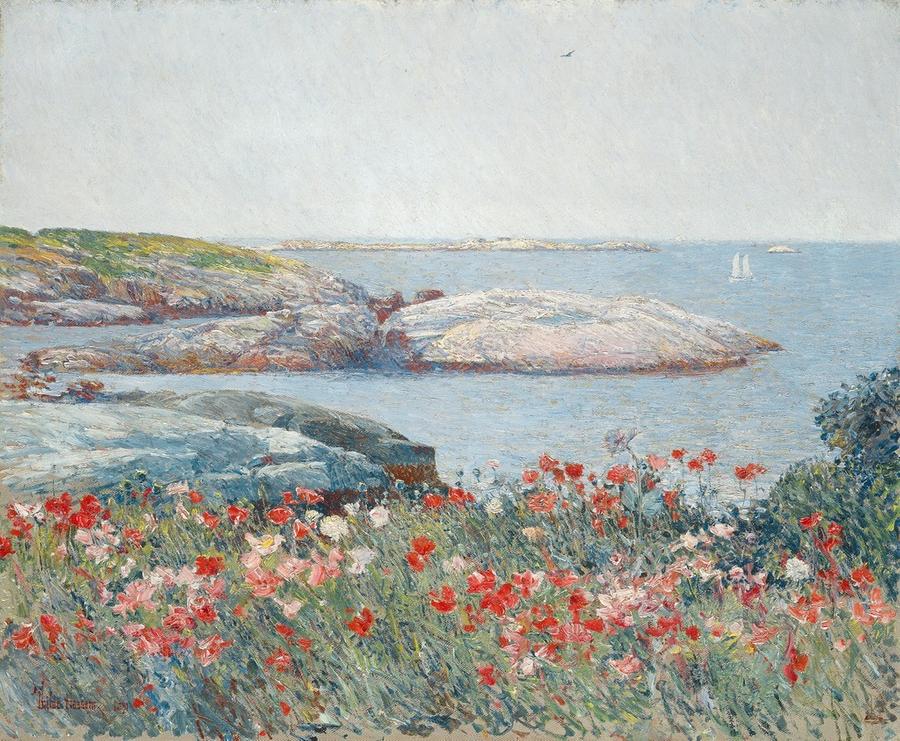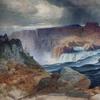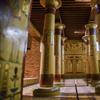PEM Captures Island Allure Through the Eyes of America's Leading Impressionist Painter
- SALEM, Massachusetts
- /
- August 01, 2016

The Peabody Essex Museum (PEM) presents American Impressionist: Childe Hassam and the Isles of Shoals, the first exhibition in more than 25 years to focus on Hassam's paintings of Appledore, the celebrated Maine island. Co-organized with the North Carolina Museum of Art in cooperation with the Shoals Marine Laboratory, the exhibition is on view at PEM from July 16 through November 6, 2016 and features more than 40 of Hassam's greatest oil paintings and watercolors of the coves, inlets, ledges and expansive seascapes that inspired his prolonged creative engagement with this alluring island. A suite of 12 contemporary black-and-white photographs by Alexandra de Steiguer also included in the exhibition artfully captures Appledore today.
Six miles off the coasts of southern New Hampshire and Maine, Appledore is the largest island in a storied archipelago in the Atlantic known as the Isles of Shoals. Over the millennia, exposure to waves, wind, sun and ice has severely weathered the island, a process that is ongoing and relentless. When Hassam stepped off the ferry onto the rocks of Appledore Island, he found a contained and nuanced place that would occupy his imagination for three decades. Hassam began regularly visiting Appledore in 1886, a time when art critics had already cited him as the earliest American champion of the Impressionist movement and considered him one of the most talented painters of his generation. Freed at Appledore from the stifling pressures of the urban art worlds of Boston, New York and Paris, Hassam fell under the spell of the Isles of Shoals, returning almost every summer until 1916.
Comfortably ensconced in a rambling resort, waking to bright sun and Atlantic breezes, the artist gave himself over to painting en plein air and created a body of work that remains a pinnacle of American Impressionism. Works selected for the exhibition date from the late 1880s to 1912 and offer a sustained reverie on nature, the pleasure of painting and a rapturous sense of place and color: a celebrated island garden with its gem-like flowers; dense thickets of bayberry wedged in granite crags; and the dark ocean breaking against rocks and swirling in tidal pools. As Austen Barron Bailly, PEM's George Putnam Curator of American Art, notes, "this exhibition explores how the artist Childe Hassam found such variety and creative inspiration from what is essentially a speck of granite in the Atlantic Ocean."
Island inhabitants
The initial interest for Hassam was the exquisite garden of poet and painter and local celebrity Celia Thaxter. Appledore's greatest champion, Thaxter published An Island Garden in 1894 with illustrations by Hassam. Over four summers, Hassam painted Thaxter's garden and the views from her cottage piazza. Her flourishing cultivated plot scarcely bound by its 15-by-50-foot wooden fence and overlooking Babb's Rock provided the staging for the painter's first in-depth exploration of Appledore's scenery.
Beginning in 1848, vacationers began flocking to Appledore's grand hotel to escape the hassles of modern life. The island also boasted gabled cottages, a cobble beach with rowboats and daysailers, a saltwater bathing pool with cabanas, and tennis courts. At the height of the season, the dining hall of The Appledore House would host upward of 300 well-heeled guests. They would stroll the circuit road, survey the geological marvels and watch the Atlantic's waves crash against the shores. On the west side, they would swim the sheltered coves and play tennis on the nearby courts. At the end of a leisurely day, many would head to the hotel's wonderfully wide porch to take in a sunset.
Although Hassam enjoyed the island society on his working vacations, he never painted its throngs. Instead he crafted and created more pure, unpeopled landscapes on Appledore than anywhere else. After Thaxter's death in 1894, Hassam shifted his attention away from the primary domain of his influential friend. He searched for the more rugged and lyrical dimensions of the island: the geology of its coves and the beauty of the surrounding sea.
Accessing nature
On a treeless island, painting could not have been all pleasure. One has only to stand on the exposed rocks where Hassam painted to marvel at the artist's fortitude. The midsummer sun would have left the painter scorched, even if shaded by an umbrella. Gusty salt breezes would have played havoc with a stretched canvas. When the breeze stills, insects would rise from the tidal pools. Though Hassam found a few good sites along the road that circled the island, he mostly looked off-road, scrambling up rocks and boulders.
Hassam painted The South Gorge in 1912, his most adventurous year on Appledore, during which he added a number of new and hard-to-reach places to his repertoire of subjects. Most of the resulting paintings are watercolors, which offered a practical advantage over oil painting. It was more portable, requiring only a block of paper, a lidded tin case with pans of soluble color, assorted pencils and brushes, and, of course, water. No set-up was required. Thus, only lightly encumbered, the artist was able to reach locations that had previously eluded him.
A fresh approach
For the first time, art historians have teamed up with marine scientists and geologists to analyze and interpret the paintings of the famous American Impressionist and map Hassam's painting sites to the island's terrain. The new discoveries came about through a partnership between John W. Coffey, deputy director and curator of American and modern art at the North Carolina Museum of Art, and Bailly, PEM's George Putnam Curator of American Art, who collaborated with Kathleen M. Burnside, co-director of the Childe Hassam Catalogue Raisonne and Hal Weeks, formerly of the Shoals Marine Laboratory, a summer marine sciences program for undergraduates sponsored by the University of New Hampshire and Cornell University.
"This exhibition combines Hassam's best and most virtuosic interpretations of Appledore with a rigorous assessment of his specific subjects around the island. Documenting Hassam's exact painting sites through our curatorial fieldwork has helped us understand how the artist observed and reinterpreted the island's nature," said Bailly. "Simultaneously collapsing and highlighting distinctions between Appledore in Hassam's day and Appledore now enriches our appreciation of Hassam's methods and deepens our understanding of his artistic range."
An interdisciplinary team of experts has been able to determine how Hassam adjusted his position in relation to rocks and pools, discovering how he often reframed, or manipulated the views, variety and pattern of his rugged and watery surroundings. "Revisiting Hassam's sites on Appledore reveals that the island became Hassam's escape and his artistic laboratory, the one place he could always go to experiment and test his own aesthetic responses to composition, texture and color seen up close or from a distance," said Bailly.
Appledore today
Today, teams are working to return Thaxter's garden to its former glory. With the help of an archeological dig, the Shoals Marine Laboratory has recently renovated the garden to capture the exact layout of her original plot. Heirloom seeds have been planted according to the original layout and students from the University of New Hampshire are helping maintain the garden as well as a greenhouse, employing Thaxter's methodologies by planting seeds in eggshells and utilizing a passive rainwater irrigation system.
To create a counterpoint to Hassam's portrayals of the island, contemporary artist Alexandra de Steiguer was commissioned to create a suite of black-and-white photographs for the exhibition's accompanying publication. De Steiguer is winter caretaker of the Star Island Family Conference and Retreat Center on neighboring Star Island, New Hampshire, where she has been the sole occupant of the island for the last 19 winters. Her annual experience of the Isles differs starkly from the balmy summers that Hassam would have enjoyed. But her familiarity with the landscape of the Shoals and her resulting modern portrait of Appledore resonates with Hassam's art and his extended relationship with the island he loved.
















